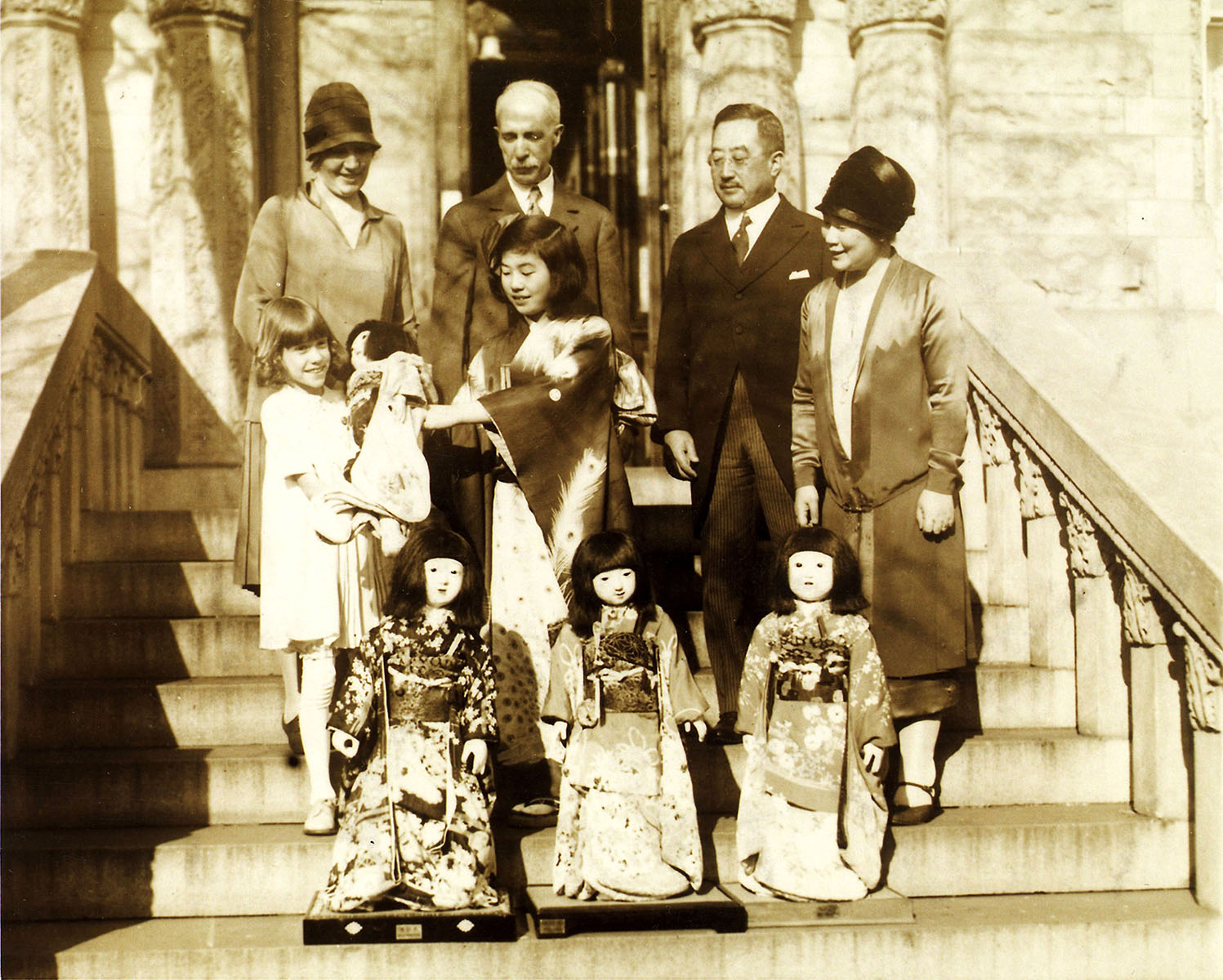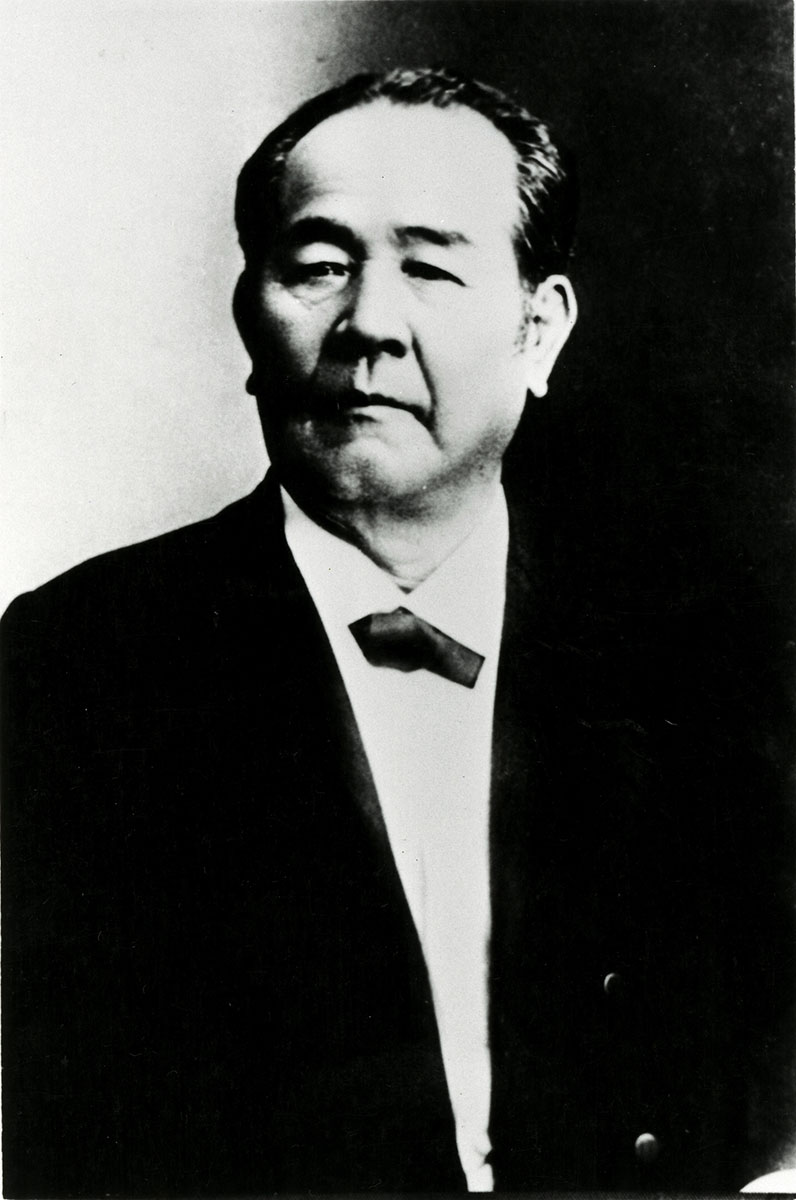公開日 2021年11月12日
Blue-eyed Friendship Doll in Oyama Elementary School
3. Doll Exchange Project ~ Gulick and Eiichi Shibusawa
Nowadays, grass-root international exchanges are quite common, a trail for which might have been blazed by the Doll Exchange Project between Japan and the US. Sidney Gulick, an American missionary,and Eiichi Shibusawa, a Japanese industrialist and capitalist, could be said the founders of the project.
Sidney Lewis Gulick (1860 ~ 1945) was dismayed by the anti-Japanese movement in the US. He was born in a small island among the Marshall Islands as a son of a missionary, and brought up for some period in Asia. He spent his high-school and college days in the US. He learned at Union Theological Seminary in New York. In 1877, he, like his father, became a missionary of the American Board of Commissioners for Foreign Missions (founded in 1810 as the first organization in the US for foreign missions). The next year, he came to Japan to conduct missionary work and lived in Kumamoto, Osaka, Matsuyama and Kyoto. Since 1904, he taught theology and science as a professor of the faculty of theology at Doshisha University. Until he returned to the US on sick leave in 1913, he taught also at Kyoto Imperial University and Baika Girls’ High School. He stayed in Japan for 25 years in total as a great Japanophile.

- The Welcome Party in Washington D.C.
- Gulick is in the center of the back row.
- (photo:owned by Shibusawa Memorial Museum)
In the year he returned to the US, California State Assembly passed the Alien Land Law, which prohibited the Japanese immigrants from owning lands. Gulick, even though he was ill, started the campaign immediately to repair the relations between Japan and the US. Writing the book titled ‘the American Japanese Problem’, he worked on the Christian Confederation and liberalists to amend the anti-Japanese legislation. He also met President Wilson and suggested the immigration law fairer for Japanese immigrants, emphasizing the importance of the good relationship between the US and Japan. In 1923, he established ‘World Committee on International Friendship among Children’, which he encouraged members of children’s organizations and of Sunday schools to join, with a view to cultivating international understanding as early as in childhood. The passage of New Immigration Law (Anti-Japanese Immigration Law) despite his great effort didn’t stop him. As the chief of World Committee on International Friendship among Children, he promoted the project to send American dolls to Japan for Hina Matsuri (Doll Festival) on March 3rd, which was a familiar festival to Gulick, in which parents arrange hina dolls in a traditional way wishing for their daughters’ growth and happiness. The popular song titled ‘Blue-eyed Dolls’, which was sung widely by Japanese children at that time, also encouraged him. About 2.6 million people in the 48 states throughout the US cooperated for his project.

- Eiichi Shibusawa
- (Photo:owned by Shibusawa Memorial Museum)
Eiichi Shibusawa (1840 ~ 1931) was born as a son of a village head in Hanzawa County, Musashi Province (present Saitama Prefecture), and became a retainer of Hitotsubashi Tokugawa family at the end of the Edo period. In 1867 (the last year of the Edo period), he visited Europe as an attendant for Akitake Tokugawa and learned modern industries and financial systems in Western countries. After the Meiji Restoration, he joined the Ministry of Finance and exerted himself to establish the modern financial system in Japan. After retiring in 1873, he established such companies as First National Bank, Osaka Spinning Company (present TOYOBO), Oji Paper Company, Japan Railway Company and so on. The coexistence of profit and ethics being his basic management policy, he not only supported culture, but also established more than 600 nonprofit social and educational organizations such as Tuberculosis Prevention Association, St. Luke’s International Hospital, Blind Welfare Association, Tokyo Nursing House and so on, which illuminated him as a philanthropist. After retiring from the business world, he devoted the rest of his life to the solution of the issue of the exclusion of Japanese immigrants in the US.
Gulick and Shibusawa first met one year before Gulick left Japan for the US. That year, Jinzo Naruse (the founder of Japan Women’s University), a good friend of Shibusawa’s, established Kiitsu Kyokai, an association to correct the current trend of thought and to promote international friendship, cooperated by Shibusawa and Ichizaemon Morimura (the founder of Morimura Brothers Co. and Morimura Bank). To its first meeting were invited Gulick as well as Tetsujiro Inoue, Masaharu Anesaki, Bin Ueda and Kazutami Ukita. From then on, Gulick, attracted by Shibusawa’s personality, became his close friend. Since Shibusawa was not a good English speaker, Gulick was the only pro-Japanese American that was able to communicate with him directly in Japanese. As mentioned above, the issue of Japanese immigrants in the US became all the more serious while their friendship became all the closer after Gulick temporarily returned to the US. The adoption of New Immigration Law in 1924 changed the Japan-US relation for the worst. While the movement Shibusawa started to amend the immigration law was too political to be effective, Gulick was obliged to seek for other soft-line methods. The doll-exchange project, not a political but an educational movement, was a bright idea that only Gulick as a Japanophile could have hit upon on such a rocky road.
The relevant ministries in Japan, the Ministries of Foreign Affairs and of Education, struggling to cope with this Gulick’s proposal, requested cooperation from Shibusawa, Gulick’s old and close friend. Shibusawa, a private citizen at that time, willingly accepted the request. Responding to Gulick’s proposal, Shibusawa established ‘Japanese Committee on International Friendship among Children’ and became its president. He encouraged the Japanese government, which was rather reluctant at first, to join and support the project. The Ministry of Foreign Affairs was requested to exempt import duties, while the Ministry of Education to distribute the dolls from the US to children all over Japan. 55% of the cost required to accept the dolls was to be borne by Shibusawa, and the rest by Japan-US Relations Committee (24% by the Ministry of Education and 21% by World Committee on International Friendship among Children).
Though the people concerned were skeptical of the effectiveness of the friendship doll project at first, the project produced a sensation beyond their expectation, starting to improve the Japan-US relation deteriorated by the immigration law and to enhance the Japan-US friendship. Shibusawa, considering this situation the best chance, decided, after consulting with Tsuneo Matsudaira, the US ambassador, to make and send 58 Japanese ichimatsu dolls back to the US as Christmas presents. The 58 dolls were made by doll makers including Goyo Hirata, who was later designated as a living national treasure. Each doll, given her own name, household articles to accompany her at marriage, passport and passage ticket, crossed the Pacific Ocean and was kept carefully in the US. This doll exchange project might be the best example of private-sector intercultural exchanges.
Next⇒4. Blue-eyed Dolls Coming to Japan
- 1. Introduction
- 2. Relations between Japan and the US in Those Days
- 3. Doll Exchange Project ~ Gulick and Eiichi Shibusawa
- 4. Blue-eyed Dolls Coming to Japan
- 5. Torei Ningyo (Dolls of Gratitude) Sent across the Pacific Ocean
- 6. From the past to the future
Previous⇒2. Relations between Japan and the US in Those Days


